Work/Energy
AVERY WILLIAMS
The Main Idea
Up until this point, we've worked in applying the Energy Principal in situations where there is no work. Therefore, the energy equation would reduce to (assuming theres no heat lost to surroundings) ΔE = 0 or Esystem = Esurroundings. But what if there is work? It is important to note that the definition of work is the transfer of energy between the system and the surroundings due to some force. Also only the component of the force that is parallel to the displacement of the system contributes to the work done by the surroundings. In this section we will cover what work is and how we will use it.
Work is a movement of an object in the direction of the force applied to it. A person pushing a box, jogging to work, and pulling a wagon are all doing work. We will be using work in the context of The Energy Principal in a moment but first lets look at the mathematical definition of work.
A Mathematical Model
There are two definitions of work: one where work is constant and one where it is not. When force is constant, it can be defined as W= F . Δr. When the force is not constant, the best definition of work is as an integral, expressed as: [math]\displaystyle{ \int{F}\, dx }[/math]. This is the integral (evaluated over bounds from initial to final position) of the force times the change in position.
Dot Products
A dot product is a mathematical operator that serves to multiply two vectors. It is crucial to the idea of work, because under a constant force, Work can be expressed as W = [math]\displaystyle{ \vec F }[/math] ∙ [math]\displaystyle{ \vec x }[/math].
Algebraic Computation
To compute the dot product of two vectors, multiply the first element in either vector together and add them all up.
For instance, <3,2,1> ∙ <5,6,7> could be written as (3*5)+(6*2)+(7*1) and would equal 15+12+7 = 34
Take note that taking the dot product of two vectors yields a scalar
Geometric Explanation
Taking the dot product of two vectors can give you a feel for the positions of those two vectors in space. For example, the dot product of two perpendicular vectors is zero.
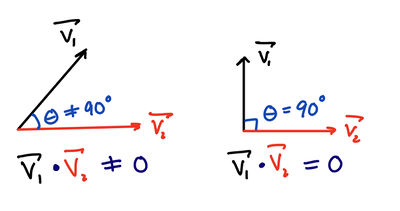
Practice Problems
Compute the following dot products
1) <34,2,7>∙<2,1,0>
2) <0,0,0>∙<930843029,43982048,43291>
3) <1,1,1,0,7,3,2>∙<2,4,2,5,7,8,0>
Answers:
1)69
2) 0
3)81
Under a constant force, this can be expressed as W = [math]\displaystyle{ \vec F }[/math] ∙ [math]\displaystyle{ \vec x }[/math]. This will often be the formula used in this course. Keep in mind that this is a dot product, so if these two vectors are perpendicular to one another, the dot product (and therefore the work) will equal zero. This is a key connection to be made about work.
A Computational Model
INSERT INFO ABOUT COMPUTATIONAL MODEL HERE
Examples
Easy
A jogger goes for a 3 mile jog around a lake averaging 3m/s. She starts and finishes at her home. How much work does she do?
Solution: The formula for work is (FORMULA). In this problem, the Δx is zero, because the jogger ends up at the same place she started. Therefore, the total work is zero.
Medium
A 5kg box is dragged 2m across the floor with a rope pulling with a force of 10N at a 30 degree angle. How much work is done?
Solution:
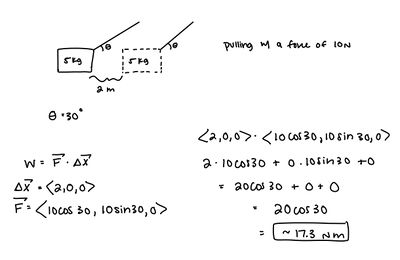
Medium
Hard
Hard
You hang by your hands from a tree limb that is a height L above the ground, with your center of mass a height h above the ground and your feet a height d above the grown, as shown in the figure (not to scale). You then let yourself fall. You absorb the shock by bending your needs, ending up momentarily at rest in a crouched position with your center of mass a height b above the ground. Your mass is M. You will need to draw labeled physics diagrams for the various stages in the process.
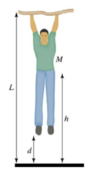
Connectedness
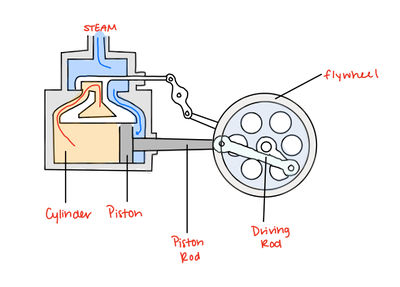
As discussed in the "history" section of this page, the term "work" has close ties to the invention of the steam engine. A steam engine works in two major steps.
(1) A fire heats up water to make steam
(2) the steam causes a piston to move up and down, powering some sort of engine.
This simple and effective invention was used widely in the seventeen and eighteen hundreds to transport ships across waterways and make factories have functioning machinery. The concept of turning thermal energy, which can be difficult to harness into mechanical energy, which is easy to use, revolutionized transportation and automation - and it all relies upon the concept of work!
History
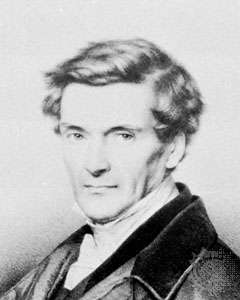
see citation 1
The concept of work is so fundamental to our modern understanding of physics that it is difficult to trace back its exact origins. It is thought, though that french mathematician Gaspard-Gustave Coriolis was the first to coin the term. At the time, he didn't understand the wide reaching applications of the term but used it nonetheless in a paper he published in 1835 to describe a force acting over a distance. He did not intend it to be used in a wide variety of disciplines in science (particularly in physics), but rather for it to be a term describing the motion of steam engines in producing energy.
The scientist who made "work" into the term it is today is Solomon of Caux. He too worked closely with steam engines but broadened and popularized the term work into what more closely resembles how we use it today.
Since that time, its mathematical and conceptual definition has become more complete and is pops up in many different disciplines from Classical Physics to Thermodynamics.
More Info
(1) https://www.britannica.com/biography/Gustave-Gaspard-Coriolis
(2) https://www.lindahall.org/gustave-coriolis/